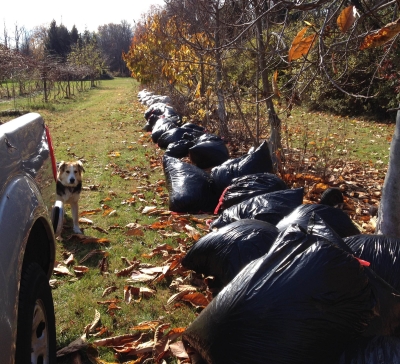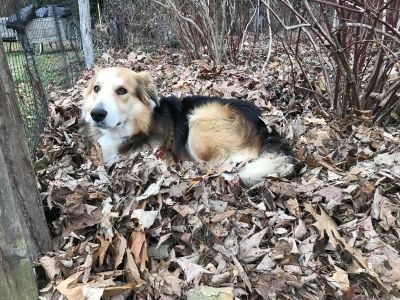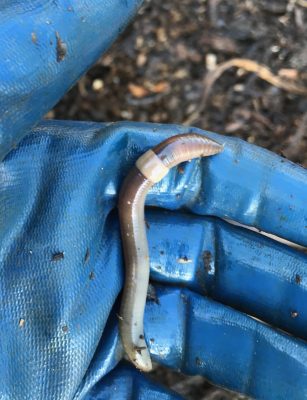Of Worms and Leaves, Here and Beyond
Unreiking is Good Exercise
For the past few days I’ve been engaged in the esoteric exercise of unreiking. Basically, this involves lifting heavy (or sometimes light) sacks, slitting them with a knife, and then moving my arms back and forth over the spilled contents. Okay, okay, the “sacks” are plastic bags, their contents are autumn leaves, and I’m holding a pitchfork in my hands as I spread out the spilled leaves.

Sammy is looking forward to this leafy mattress
(Unreiking is the reverse of another esoteric exercise, reiking, whereby . . . well, leaves are raked up into plastic bags.)
Some people have too many leaves or otherwise don’t want them around. I have too few leaves and have use for them. By unreiking, the leaves get spread beneath my berry bushes, grape vines, and pear trees. These leaves feed bacteria, fungi, and other soil microbes, which slowly rot down the leaves to enrich the ground with nutrients and add organic matter that helps the soil hold both moisture and air.

Ahhhhhh
After doing this autumn after autumn for many years, the ground beneath these plants is as good as any agriculture soil in the world.
A Gardener’s, Farmdener’s, and Farmer’s Friend, Reconsidered
Our forest soils are similarly enriched, though to a lesser degree, with each autumn’s leaf drop. But change is under way, and the culprit is the earthworm.
Backtrack to about 12,000 years ago; that’s when the last glacier receded from the northern parts of the U.S. The glacier froze, compacted, churned and moved soil everywhere north of New Jersey, the upper parts of Pennsylvania, Ohio, Indiana, and Illinois, and parts of Wisconsin and South Dakota. Most of North Dakota was also enveloped by the the glacier, as well as, moving further west, the northern parts of the northern most states. In so doing, it killed off any native earthworms.
The still existing native earthworms to the south could have migrated back up here, but they move very slowly. Earthworms’ top speed is estimated at less than 6 yards per year.
Here, north of that line of glaciation, you and I do see earthworms in our soil. They’re not native; they arrived here nestled within pots of soil and organic debris, and as discarded soil ballast in ships, beginning in about the 17th century, with European colonists. And they liked it here.
More recently, those European immigrants — the worms, that is — were joined by worms from Asia.
Both species of non-native earthworms continue to spread in the soil of potted plants, in compost and leaf mulches, in home composting kits, and in discarded fishing bait (“nightcrawlers”).
Problem is that a few species of these non-native earthworms are very good a decomposing the leafy mulch that blankets forest floors. The blueberry, mountain laurel, rhododendron and other shrubs and ground covers in our forests thrive in that leafy mulch. The action of these non-native earthworms threatens to change the character of our forests.
Eek, A Snake Worm!
A number of years ago, my friend Sandy told me of strange happenings in her garden, of the abundance of worms and worm castings to the extent that the soil became so loose that her plants were flopping over. I pooh-poohed this report until a bit of research revealed this invasive worm issue.
I couldn’t offer Sandy any advice on what to do and, in fact, there’s no recommended way to deal with invasive worms. Discarding fishing bait at the end of a fishing day is one way these worms spread. (Sandy’s husband does fish.) They also can be spread in potted plants and in composts that were insufficiently heated and in mulches. (Uh oh; what about all my leaf hauling?)
For all the compost I make and spread, and all the leaves and other organic materials I haul here to the farmden, I come upon surprisingly few worms. One did catch my eye the other day, something about the way it moved and its robustness.

Crazy snake worm?
Could it be the European Lumbricus terrestris? Could it be the Asian “crazy snake worm”(probably Amynthas agrestis or A. tokioensis). Judging from the crazy way it moved and the pale collar (clitellum) circling its body completely, I’m guessing it’s one of the crazy snake worms.
Earthworms have always been a friend of gardener and farmer. Charles Darwin was a notable champion of them. After spending a lot of time on his belly in observation of these creatures, he wrote up his observations in a book, The Formation of Vegetable Mould through the Action of Worms. Darwin calculated that earthworms (probably Lumbricus terrestris) brought 18 tons of nutrient-rich castings to the surface per acre per year, in so doing tilling and aerating the soil while rendering nutrients more accessible for plant use. He wrote that “worms played a more important role in the history of the world than most persons would at first suppose.”
In our forests, European and Asian earthworms can eliminate leaf litter and change the soil composition to create conditions that favor non-native plants, decrease native plant biodiversity, and result in less understory vegetation. To the gardener and farmer, earthworms are a friend.

